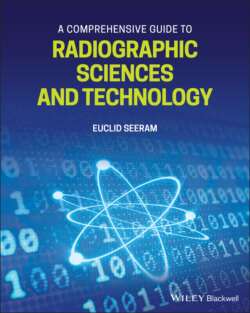Читать книгу A Comprehensive Guide to Radiographic Sciences and Technology - Euclid Seeram - Страница 14
1 Radiographic sciences and technology: an overview
ОглавлениеRADIOGRAPHIC IMAGING SYSTEMS: MAJOR MODALITIES AND COMPONENTS
RADIOGRAPHIC PHYSICS AND TECHNOLOGY
Essential physics of diagnostic imaging
Digital radiographic imaging modalities
Radiographic exposure technique
Image quality considerations
Computed tomography – physics and instrumentation
Quality control
Imaging informatics at a glance
RADIATION PROTECTION AND DOSE OPTIMIZATION
Radiobiology
Radiation protection in diagnostic radiography
Technical factors affecting dose in radiographic imaging
Radiation protection regulations
Optimization of radiation protection
Bibliography
Radiographic Science and Technology have evolved through the years, ever since the discovery and use of x‐rays in 1895. This evolution has resulted in the introduction of physical principles and technology with the major goal of improving the care and management of the patient. Furthermore, a significant benefit of these innovations is focused on reducing the radiation dose to the patient without compromising image quality. Radiographic sciences deal with the physics of various diagnostic imaging modalities (radiography, fluoroscopy, mammography, and computed tomography [CT]) and include x‐ray generation, x‐ray production, x‐ray emission, and x‐ray interaction with tissues. Furthermore, radiographic sciences also address radiation risks and radiation protection. Radiographic technology, on the other hand, addresses the equipment components and how they function to produce diagnostic images, image quality characteristics, and quality control (QC) aspects of these imaging modalities.
The workhorse of radiology has been film‐screen radiography which is now obsolete and has been replaced globally with digital imaging. The scope of digital imaging is extremely wide and now involves a basic understanding of computer sciences, to explain how the new digital imaging modalities work. These modalities include computed radiography (CR), flat‐panel digital radiography (FPDR), digital fluoroscopy (DF), digital mammography (DM), digital tomosynthesis, and CT. In addition, the digital imaging environment now demands that operators understand what has been referred to as “imaging informatics,” an area of study that involves picture archiving and communication systems (PACS), enterprise imaging, Big Data, machine learning (ML), deep learning (DL), and artificial intelligence (AI).
With the above in mind, various professional organizations such as the American Society of Radiologic Technologists (ASRT), the Canadian Association of Medical Radiation Technologists (CAMRT), and other professional medical imaging organizations throughout the world have prescribed curricula for diagnostic imaging programs which provide guiding, principles that assist academic program leaders in designing foundational learning outcomes that are intended to meet the professional standards, and more importantly meet the entry requirements for clinical practice. Institutions offering educational programs in diagnostic imaging should be then able to raise the level of these foundational learning outcomes and content to meet the requirements of degree programs, including graduate degree programs in diagnostic imaging.
A good example of the above is offered by the ASRT curriculum content which is organized around the following subject matter [1]: Introduction to Radiologic Science and Health Care; Ethics and Law in the Radiologic Sciences; Human Anatomy and Physiology; Pharmacology and Venipuncture; Imaging Equipment; Radiation Production and Characteristics; Principles of Exposure and Image Production; Digital Image Acquisition and Display; Image Analysis; Radiation Biology; Radiation Protection; Clinical Practice; Patient Care in Radiologic Sciences; Radiographic Procedures; Radiographic Pathology; Additional Modalities and Radiation Therapy; Basic Principles of Computed Tomography and Sectional Anatomy. Similar content is characteristic of other curricula offered by other medical imaging professional organizations around the world.
Keeping the above ideas in mind, this book will address content that are considered radiographic sciences and technology. Specifically, the chapters included present a summary of the critical knowledge base needed for effective and efficient imaging of the patient, and wise use of the technical factors that play a significant role in optimization of the dose to the patient without compromising the image quality necessary for diagnostic interpretation. Furthermore, the summaries of the technical elements of radiographic sciences and technology will assist the student in preparing to write certification examinations. As such, the major and significant principles and concepts will be reviewed in three sections as follows:
Section 1: Radiographic imaging systems: major modalities and components
Section 2: Radiographic physics and technology
Section 3: Radiation protection and dose optimization
